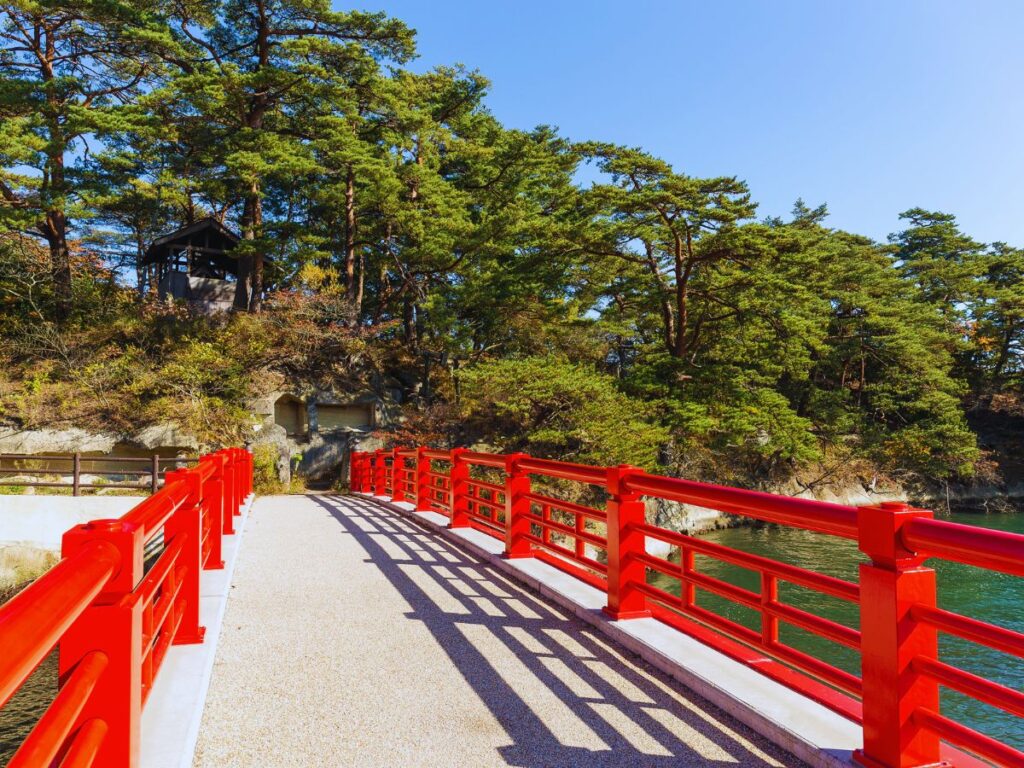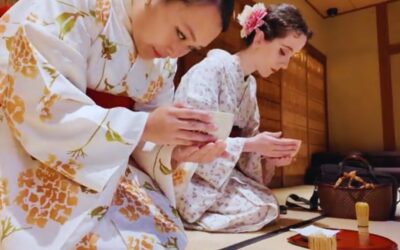Miyagi is a coastal region in northeastern Japan, part of the broader Tohoku area. It stretches from the Pacific shoreline inland to rolling farmland, rivers, mountains, and long-established hot spring towns.
For most international travellers, it’s still relatively under the radar — but that’s exactly what makes it worth knowing. This is a place where local traditions are still part of daily life, where seasonal events still mean something, and where you can see a side of Japan that hasn’t been overpackaged or smoothed out for tourists.
The prefecture’s geography means you get a lot of contrast in a short distance. To the east, you have port towns like Kesennuma, Ishinomaki, and Shiogama — places shaped by fishing culture, local markets, and a deep connection to the sea.
To the west, the terrain rises into forested hills and valleys dotted with onsen areas like Naruko and Akiu, where bathhouses have been running for centuries. And right in the middle, towns like Matsushima offer a mix of natural beauty and cultural history, with pine-covered islands, temples, and walking paths that have drawn visitors for generations.
Miyagi also has depth beyond its landscapes. The region takes real pride in its food culture — gyutan (grilled beef tongue), zunda (sweet green soybean paste), fresh oysters, and locally brewed sake all feature heavily in seasonal menus and street stalls.
Throughout the year, towns across the prefecture host events rooted in local tradition. Some are lively and festive, with fireworks and portable shrines. Others are slower, quieter — like midwinter temple rituals lit by fire. For travellers looking to step outside the usual loop and experience something grounded, Miyagi offers exactly that. It’s not flashy, but it leaves an impression.
Top Attractions in Miyagi
Matsushima

Matsushima Bay, just north of Sendai, is celebrated as one of Japan’s Three Great Views. It is one of the country’s most recognisable landscapes in Japan, known for its bay dotted with over 200 small islands covered in pine trees.
You can see the view from land, but the best way to take it in is on a sightseeing boat, which cruises between the islands and offers a much wider perspective. Several observation points around the bay also offer views from above, including Saigyo Modoshi-no-Matsu Park and Otakamori.
The town itself is walkable, with a mix of temples, coastal paths, and seafood restaurants. One of the most popular walking routes crosses Fukuura Bridge, a striking 252-metre red pedestrian bridge that leads out to Fukuura Island. The island has a forest trail, small shrine, and quiet rest areas, and the walk itself gives you a great view back toward the mainland. This bridge is a landmark in its own right and often appears in photos of the area.
Zuiganji Temple, originally from the 9th century and later rebuilt by samurai lord Date Masamune, is one of the main cultural sites. There’s also Entsuin Temple with its landscaped gardens, and Godaido, a small hall perched on a rocky outcrop just offshore. Matsushima is accessible by local train from Sendai and makes for a straightforward day trip or a peaceful overnight stay.
Naruko Onsen

Naruko Onsen is a traditional hot spring town located in the northwestern part of the prefecture, known for the variety and mineral richness of its thermal waters. It has five different onsen areas collectively called “Naruko Hot Spring Village,” each offering different spring compositions and bathing styles. You don’t need to stay overnight to enjoy them—many ryokan and public bathhouses welcome daytime visitors.
The town is also home to the craft of kokeshi doll-making, a regional folk art that dates back over a century. You can visit the Japan Kokeshi Museum or try painting a doll yourself at a local workshop.
In autumn, Naruko becomes especially popular for its colourful foliage, especially around Naruko Gorge and the nearby Ofukazawa Bridge. The area is reachable via the JR Rikuu East Line and has enough to fill a full day or a relaxed overnight visit.
Akiu Onsen and Akiu Falls
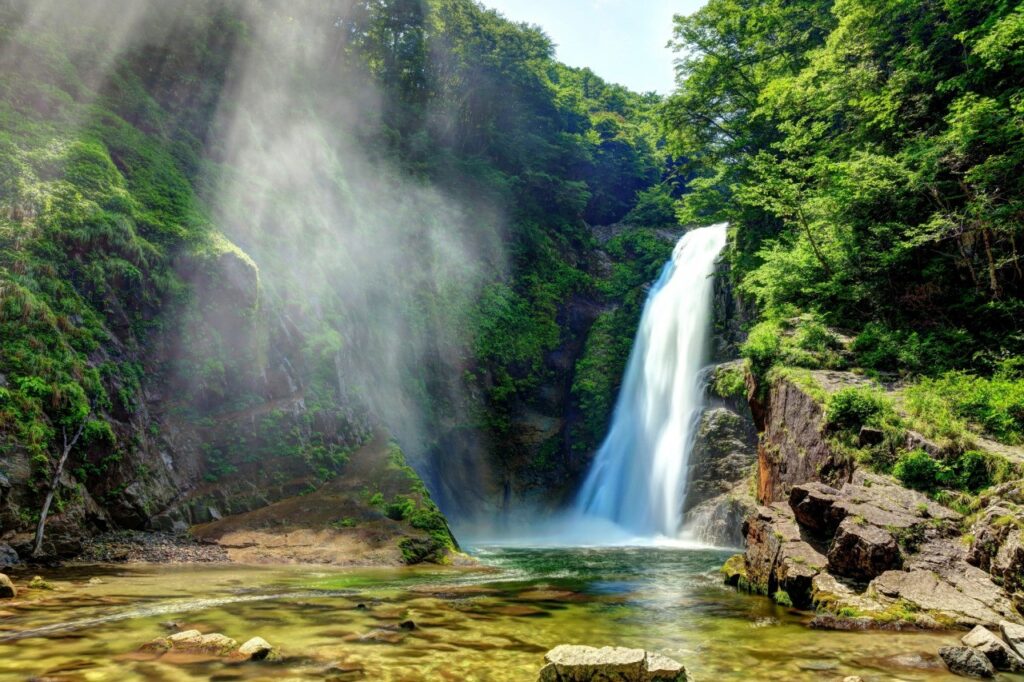
Akiu Onsen is located just outside Sendai and is one of the easiest hot spring areas to access if you’re staying in the city. The town runs along a river gorge and has a number of well-established inns and hotels offering both indoor and open-air baths. While the area feels quiet and secluded, most accommodations are modern and easy to book online.
One of the highlights nearby is Akiu Otaki Falls, a 55-metre waterfall surrounded by forested walking trails. It’s especially beautiful during autumn, when the leaves change colour, but worth visiting any time of year.
There’s also the Akiu Craft Park, where local artisans make pottery, textiles, and woodwork that reflect regional traditions. You can reach Akiu Onsen by bus or car from Sendai Station in under an hour.
Sakunami Onsen
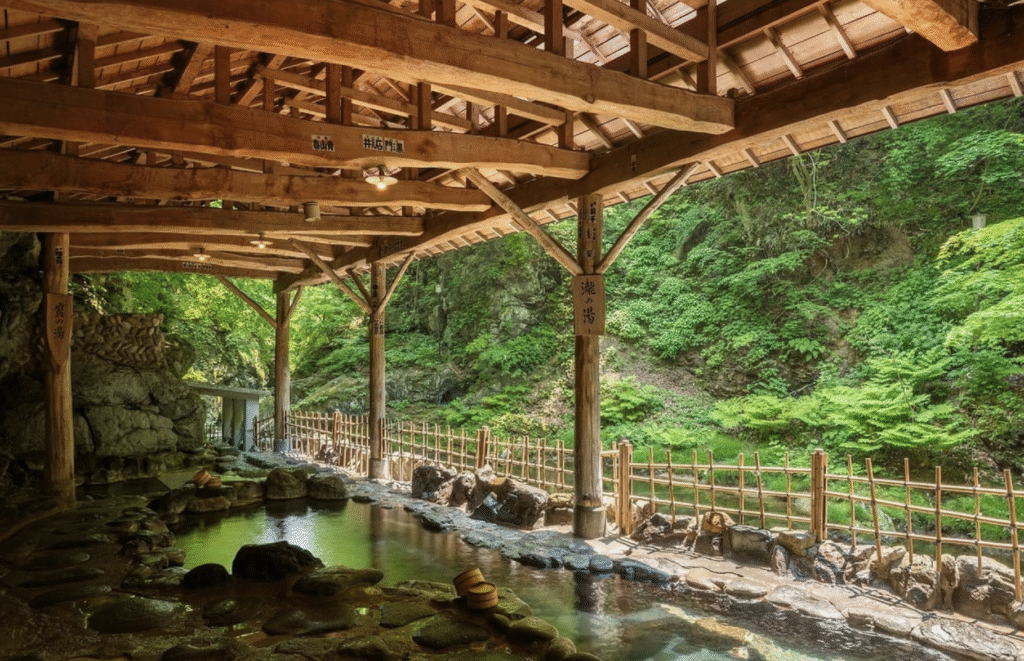
Sakunami is a small hot spring town located about 40 minutes from Sendai by train on the JR Senzan Line. Compared to more developed areas like Akiu, it feels quieter and more straightforward.
Most inns are older and traditional in style, with tatami rooms and wooden interiors. Many have open-air baths that face the river or forest, making them ideal if you’re after a simple onsen experience without large crowds or modern hotels. There isn’t much commercial development around Sakunami, which is part of its appeal if you’re looking to slow down for a night or two.
From town, it’s a short drive or taxi ride to the Nikka Whisky Miyagikyo Distillery — one of Japan’s most well-known whisky producers. The distillery is open for tours and tastings and sits between two rivers in a green valley. It’s a good addition to your trip, especially if you’re interested in Japanese drinks or want a short daytime activity between baths and meals.
Zao Fox Village & Zao Echo Line
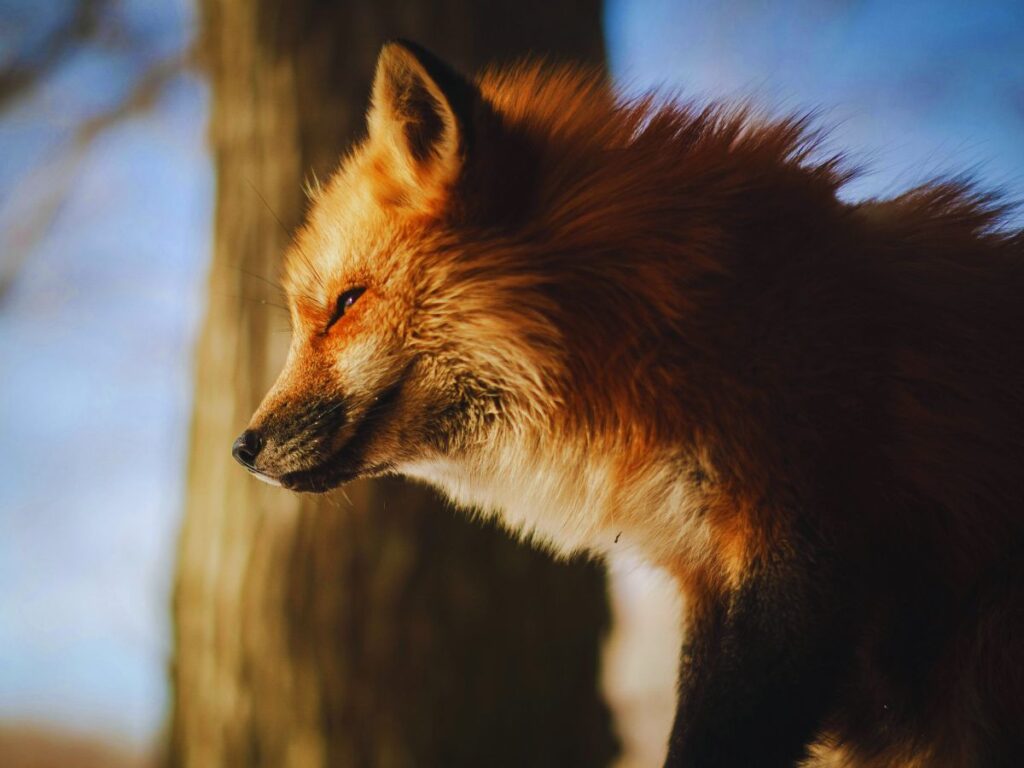
Zao Fox Village is an outdoor wildlife park near Shiroishi where over 100 foxes live in a large enclosed area. Visitors walk through the park on designated paths, and the foxes move freely around them. You’re not allowed to pet or chase them, but you can get close enough to observe them naturally.
There’s also a smaller holding area where visitors can briefly hold a tame fox under staff supervision. The facility includes a few other animals and a shop with snacks and souvenirs. Getting there takes a bit of planning — usually a train to Shiroishi-Zao Station and a 20–30 minute taxi ride. The park is open year-round, but most people visit in winter when the foxes are more active and their fur is thickest.
In the same area, the Zao Echo Line offers a seasonal mountain drive (closed in winter) known for autumn leaves and spring snow walls. From the Yamagata side, ropeways and snowcats operate tours to view the Zao “snow monsters” — trees covered in thick snow and frost. If you’re travelling in winter or early spring, it’s easy to combine both into one full day.
Sendai Umino-Mori Aquarium
Located in the coastal area of Sendai, this aquarium is the largest in the region and focuses on marine life found along the local Sanriku coast. The main tank holds nearly one million litres of water and is designed to mimic open-ocean conditions, with schools of fish, sharks, and rays. The layout is easy to follow, and most of the exhibits are bilingual, with information in both Japanese and English.
The aquarium also has scheduled sea lion and dolphin shows, touch pools for kids, and displays that highlight how the region’s coastal environment was affected and rebuilt after the 2011 tsunami.
It’s part of a redeveloped port area, which also includes shopping centres and restaurants. You can reach it by local train and shuttle from central Sendai, and it works well as a half-day visit — especially if the weather isn’t ideal or you’re travelling with children.
Aoba Castle & Zuihoden Mausoleum
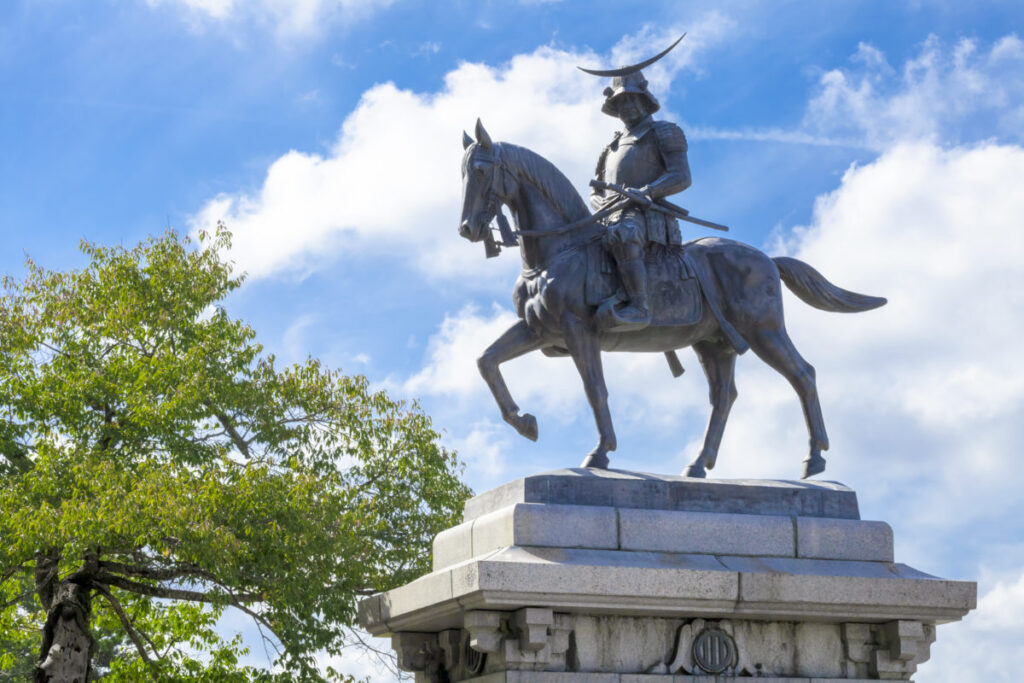
Aoba Castle, also called Sendai Castle, was originally built in the early 1600s by Date Masamune, the powerful feudal lord who founded the city of Sendai. The original structure no longer stands, but the castle site remains a popular lookout point, with wide views over the city and a statue of Masamune on horseback.
There’s a small museum on-site as well as a gift shop and some exhibits about the castle’s history. You can reach the site by bus or on foot from central Sendai, though the final stretch is uphill.
Just a short distance away is Zuihoden, the mausoleum where Date Masamune is buried. The building is a detailed example of the architectural style of the early Edo period, with bright colours, elaborate woodwork, and gold leaf decoration. It’s set in a quiet cedar forest and includes a small museum with artefacts from the Date family.
Shiogama Shrine
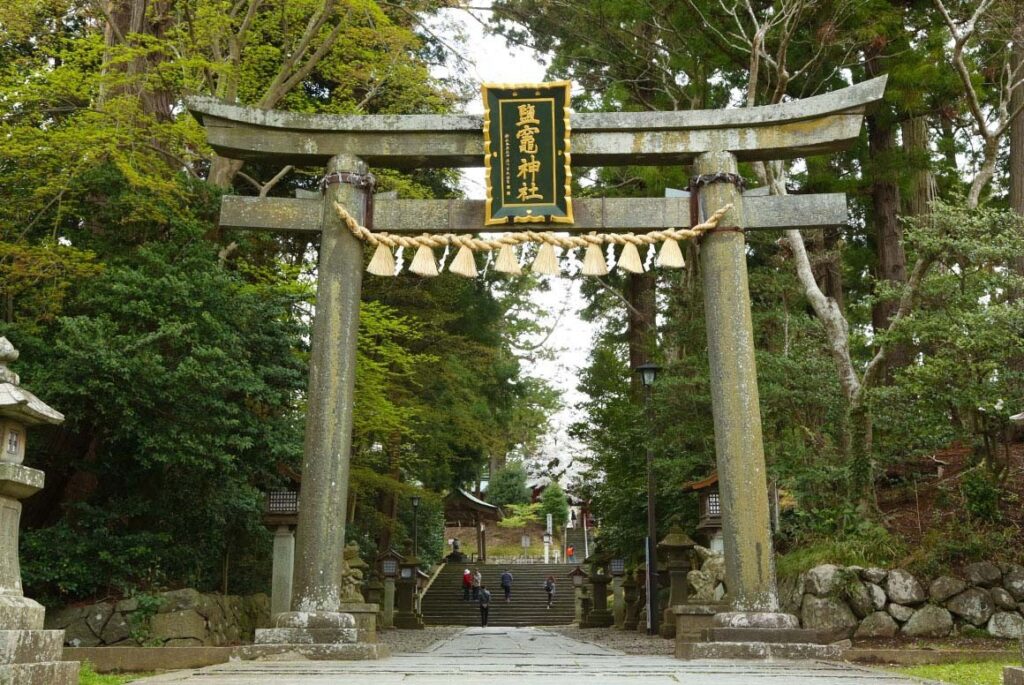
Shiogama Shrine is one of the oldest and most important Shinto sites in the Tohoku region. It stands on a wooded hillside overlooking the town of Shiogama, and its long staircase, tall torii gates, and detailed wooden structures give it a sense of scale and age.
The current buildings date back to the Edo period and are carefully maintained, with the main hall, prayer halls, and gates all recognised as Important Cultural Properties. The shrine holds several traditional ceremonies throughout the year and continues to be an active place of worship.
It is also strongly connected to the sea. Historically, it served as a guardian for fishermen and travellers along the Sanriku coast, and the town of Shiogama itself is known for salt production and fresh seafood. You can pair a visit to the shrine with lunch at one of the nearby sushi restaurants, many of which serve fish directly from the local port.
Tashirojima (Cat Island)

Tashirojima is a small island off the coast of Ishinomaki, known across Japan for its large population of free-roaming cats. The cats are protected and cared for by residents, and there are multiple shrines, monuments, and even holiday cabins shaped like cats that reflect their importance to the island’s identity.
Visitors often come for the novelty, but the island also has quiet beaches, walking paths, and an overall slow pace that appeals to people looking to get off the beaten path. There are no large shops or tourist facilities, so it’s important to bring your own food, drinks, and cash.
Accommodation is limited to a few small guesthouses and seasonal cottages. The island is reached by ferry from Ishinomaki Port, which is accessible by train from Sendai. Ferry times are limited and weather-dependent, so check schedules carefully before planning a visit. Tashirojima is best for people who enjoy quiet places, simple travel, and of course, cats.
Top Events and Festivals in Miyagi
Sendai Tanabata Festival
Held every August in central Sendai, this is one of Japan’s most famous Tanabata celebrations. For several days, the city is filled with tall bamboo poles decorated with colourful paper streamers, folded cranes, and other handmade ornaments. The decorations hang over main shopping arcades like Ichibancho and Chuo-dori, where you can walk beneath them and take in the scale of the display.
In the evenings, food stalls and performances take over nearby parks and public spaces, giving the festival a mix of traditional and casual energy. While it’s rooted in the Tanabata legend — the story of two separated stars meeting once a year — the event is also very local in character, with many of the decorations made by schools, businesses, and community groups.
Donto-sai
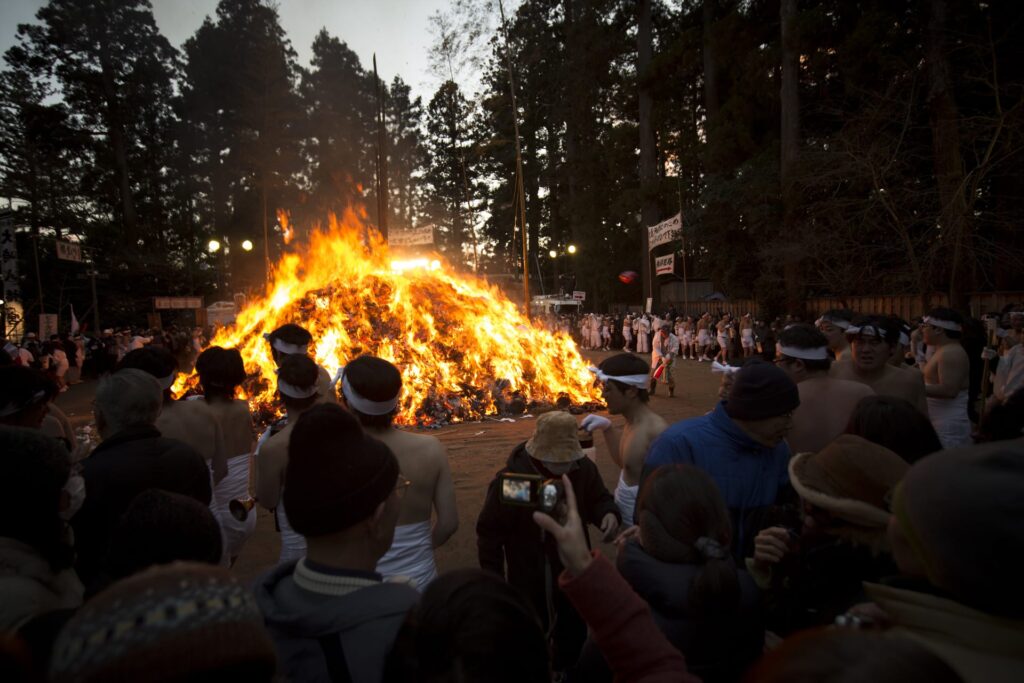
Donto-sai is a fire ritual held every January at shrines across Miyagi, most famously at Osaki Hachimangu in Sendai. The core of the festival is a large bonfire, where people bring old talismans, New Year decorations, and written prayers to be burned. The fire is seen as a way to purify the past year’s energy and start the new one clean. Participants also pray for health, good fortune, and protection in the months ahead.
A key part of the event is the hadaka mairi (barefoot pilgrimage), where local men and women wearing white clothes and headbands walk through the streets to the shrine in the freezing cold. The fire burns late into the evening, and the shrine grounds fill with warm sake, food stalls, and community stalls. If you’re in Miyagi during early January, this is one of the most unique seasonal experiences to witness.
Shiogama Minato Festival
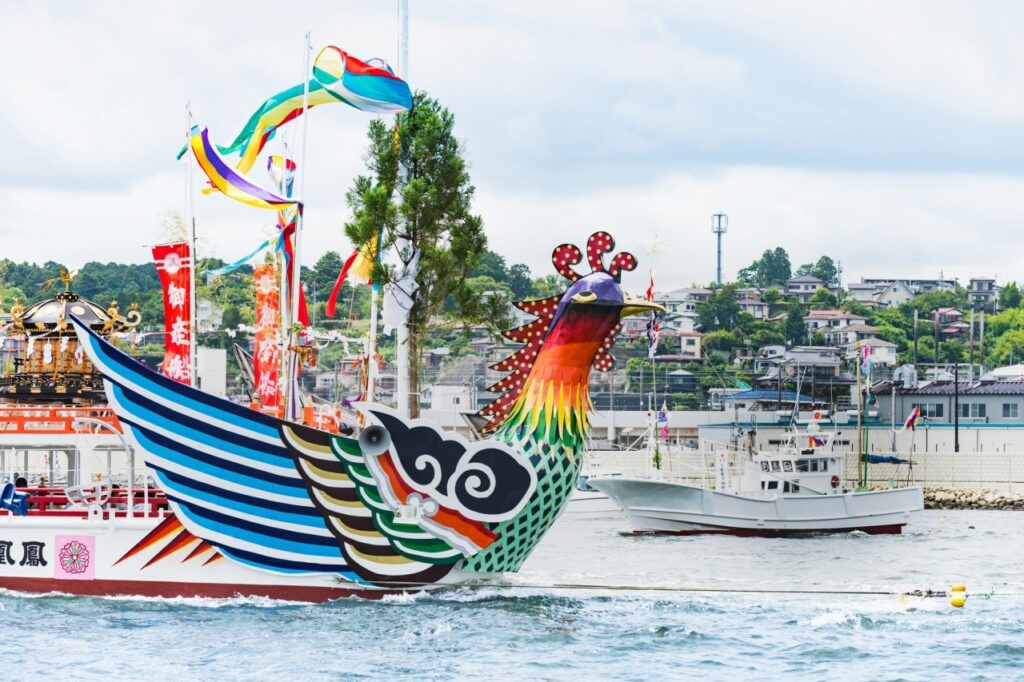
This summer festival takes place in July in the port town of Shiogama and is recognised as one of Japan’s three great boat festivals. The central event is a marine procession where two elaborately decorated mikoshi (portable shrines) are loaded onto traditional-style boats and escorted through the harbour by a fleet of smaller vessels.
The boats are rowed in rhythm to music and drum beats, and the sight of the brightly painted flotilla against the water is impressive. Before the sea procession, a large parade travels through the town, with locals carrying the shrines from Shiogama Shrine down to the port.
The entire event has a strong connection to the sea and local fishing traditions, and many families in the area have taken part for generations. Food stalls, music, and fireworks round out the day, making it one of the liveliest events in the coastal part of the prefecture. It’s easy to reach by train from Sendai and draws a crowd, so arriving early is recommended.
Zao Snow Monster Tour
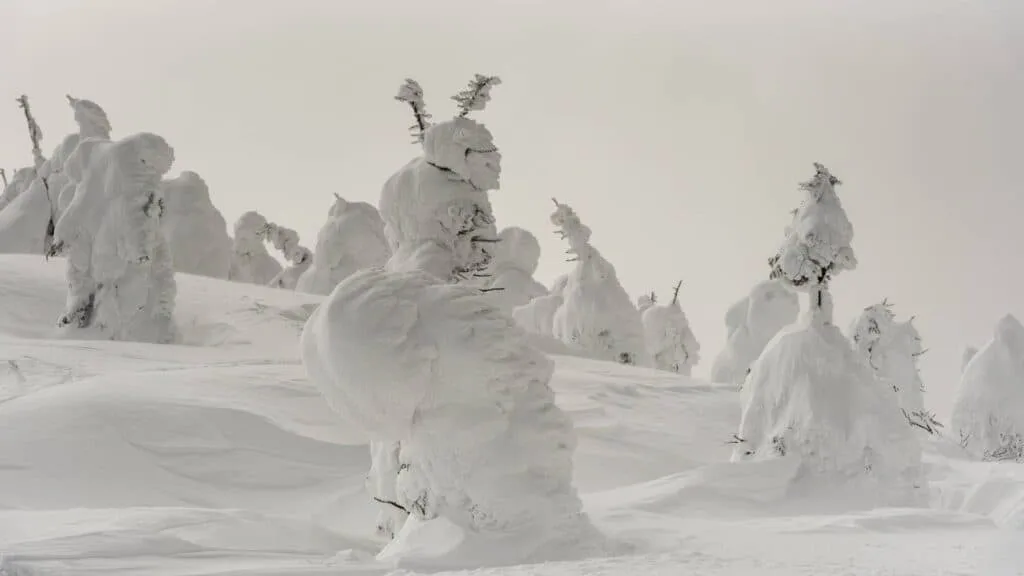
Each winter, the upper slopes of Mount Zao are transformed into a forest of frost-covered trees, shaped by strong wind and heavy snow into strange, towering forms known as juhyo, or “snow monsters.”
These natural formations appear only in very specific conditions and are visible from late December through early March, with the best viewing usually in February. It’s one of the most recognisable winter scenes in northern Japan and a key seasonal event in Miyagi.
The viewing area is accessed from the Zao Sumikawa Snow Park on the Miyagi side of the mountain. Visitors can take a snowcat—an enclosed, heated tracked vehicle—up into the forest to get a close look at the trees. There are both daytime and night-time rides available, with some evenings offering light-up events where the formations are illuminated in colour. .
Ishinomaki Kawabiraki Fireworks Festival

This is one of the largest and most well-known summer fireworks shows in the Tohoku region, held every August along the Kitakami River in Ishinomaki. It was originally started to mark the opening of the river to shipping, but today it functions as a full-day summer celebration. The show typically features over 5,000 fireworks, including large-scale set pieces and coordinated musical displays.
The riverside viewing areas fill up early, and many locals arrive in yukata with picnic mats to claim a spot in the afternoon. Leading up to the fireworks, there are live performances, food stalls, and small local events along the banks.
While it’s a festive and family-friendly atmosphere, the sheer size of the display makes it a highlight even for travellers who have seen fireworks elsewhere in Japan. Trains to Ishinomaki run from Sendai, and shuttle services are often available on the day.
Sendai Aoba Festival

Held over the third weekend of May, this festival honours Sendai’s founding by Date Masamune. It begins on Saturday evening with the Yoi Matsuri, featuring the Suzume Odori—“sparrow dance”—performed by hundreds of local groups.
Toward dusk, lantern-lit floats called Yamaboko begin their slow procession through the city centre, creating an atmospheric, glowing parade.
The main event on Sunday is the Hon Matsuri, which fills the streets with a long, 2.4 km parade. Expect to see samurai-procession reenactments, over a thousand dancers performing Suzume Odori, mikoshi (portable shrines), and six-ton floats decorated with armour and traditional motifs.
It’s free to attend, spreads across Jozenji-dori and downtown Sendai, and attracts upward of a million spectators over two days—so arrive early to grab a viewing spot.
Top Eats to Try in Miyagi
Gyutan (Grilled Beef Tongue)
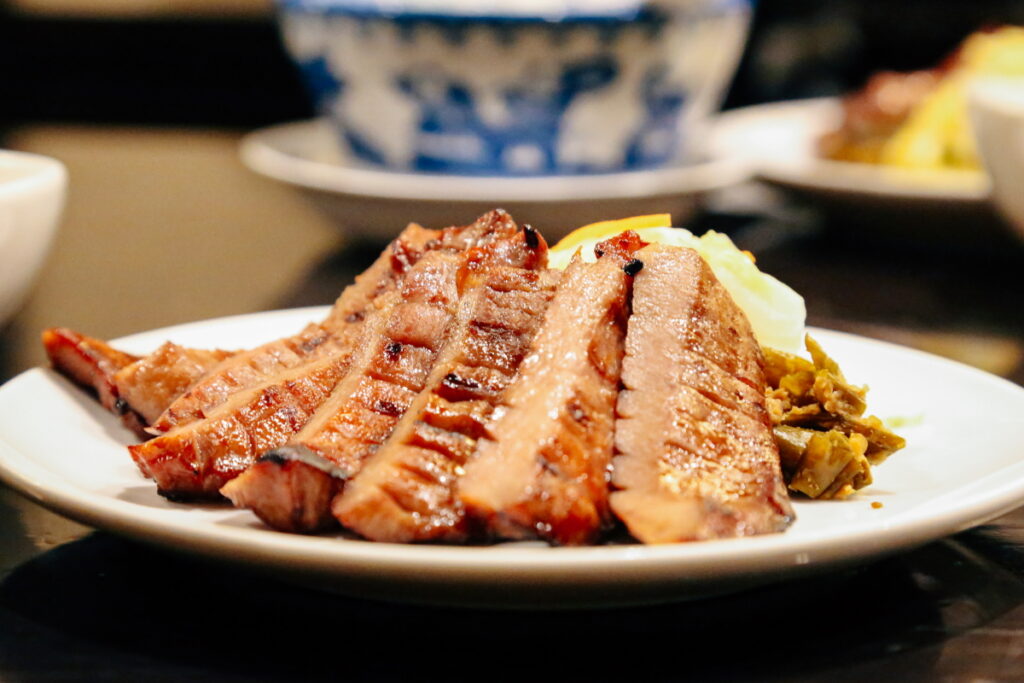
Gyutan is easily Miyagi’s most iconic dish, and it’s strongly associated with Sendai, where it first became popular after World War II. The beef tongue is sliced thick, seasoned simply with salt, and grilled over charcoal, giving it a slightly smoky flavour and a chewy, satisfying texture. It’s typically served as a set meal with barley rice, oxtail soup, and pickles.
You’ll find gyutan restaurants all over Sendai — both chains and independent spots — and it’s often one of the first local dishes recommended to visitors. Some restaurants also serve gyutan as part of rice bowls, stews, or even sandwiches, so you can try it in a few different styles. It might sound like a tough cut, but it’s surprisingly tender when prepared properly.
Zunda Mochi

Zunda mochi is a sweet dish made of soft rice cakes topped with a bright green paste made from mashed edamame (young soybeans), sugar, and a pinch of salt. It has a slightly nutty, earthy flavour that’s completely different from more common mochi toppings like red bean or sesame. Zunda is used not just on mochi, but also in milkshakes, parfaits, and seasonal sweets throughout the region.
You can find zunda-flavoured treats at souvenir shops, train stations, cafés, and dessert counters in department stores. It’s especially popular in Sendai, where shops like Zunda Saryo specialise in modern versions of the traditional recipe.
It’s a great introduction to Tohoku-style sweets and makes a good souvenir to bring home if you’re after something unique but not too unusual.
Oysters (Matsushima & Ishinomaki)
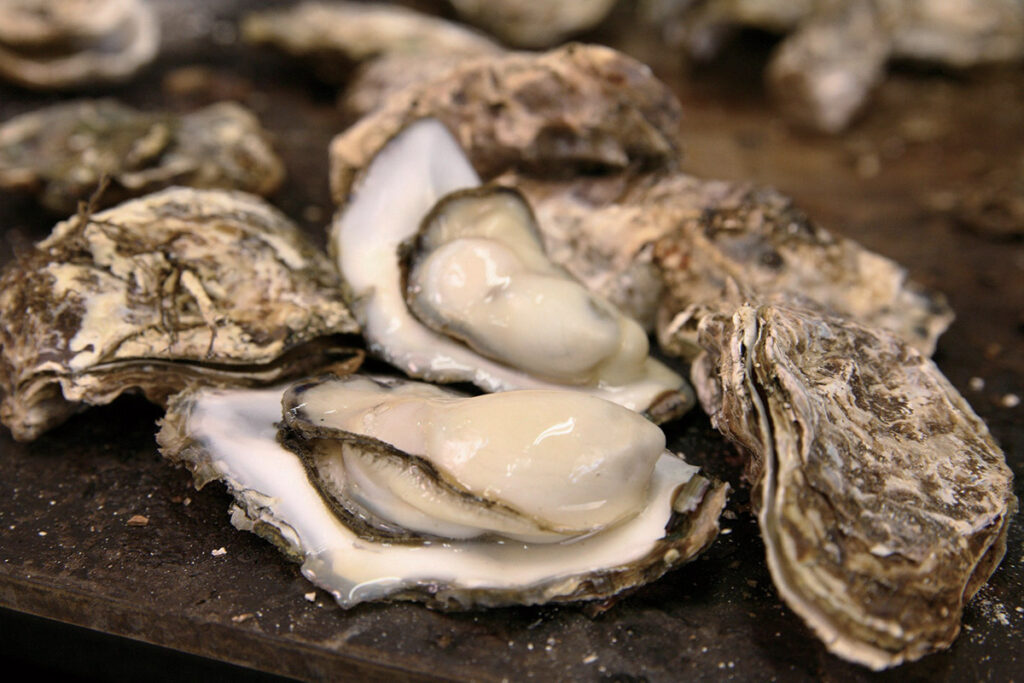
Miyagi’s Pacific coastline is known for producing some of Japan’s best oysters, and winter is peak season. The towns of Matsushima and Ishinomaki in particular are well-known for oyster farms, and you can eat them grilled, raw, deep-fried, or served in hotpots.
Some restaurants offer all-you-can-eat oyster grills, where you roast them yourself and eat them straight from the shell.
In Matsushima, oysters are a major part of the local food scene and feature in everything from oyster curry to oyster ramen. Oyster festivals and seasonal menus pop up around December to February, and if you’re in the area during that time, it’s one of the best ways to try truly local seafood at its freshest.
Sasa Kamaboko

This is a type of processed white fish cake, shaped like a bamboo leaf and lightly grilled for a toasty flavour. It’s been a staple in Miyagi for generations and is often sold as both a snack and a souvenir. The texture is firm and slightly springy, and it’s typically eaten plain, with a dab of wasabi or soy sauce, or inside a steamed bun.
Sasa kamaboko can be found in markets, food stalls, souvenir shops, and at train stations. Some stores offer workshops where you can try grilling it yourself over a flame. It’s light but savoury, and makes a good option if you want to try something regional without committing to a full meal.
How to Get to Miyagi from Tokyo
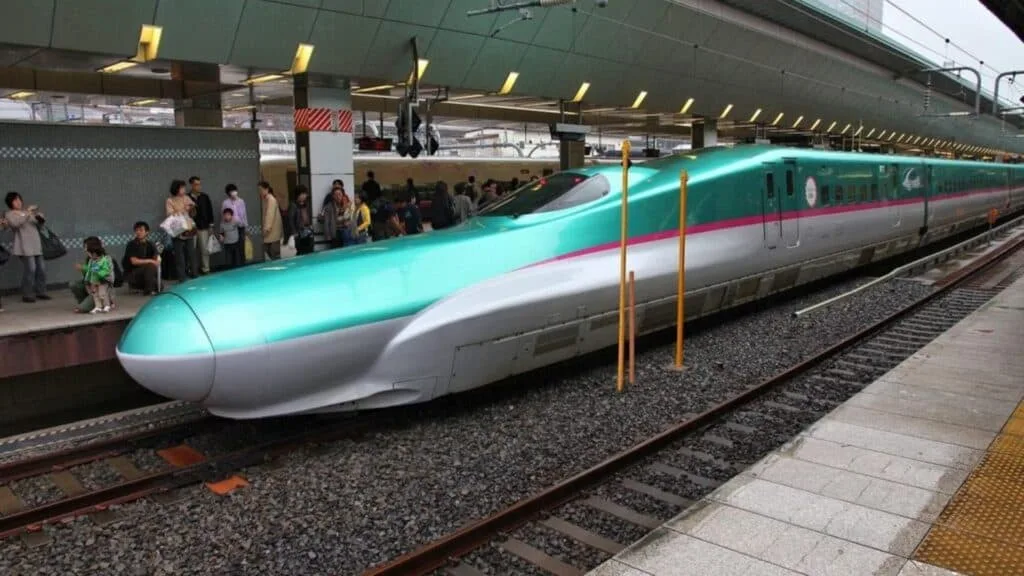
The most convenient and popular way to reach Miyagi from Tokyo is by shinkansen, or bullet train. The Tohoku Shinkansen departs regularly from Tokyo Station, with the fastest service — the Hayabusa — reaching Sendai in around 90 minutes. Trains are frequent throughout the day, and seating is available in both reserved and non-reserved sections, as well as in first-class “Green Car” carriages.
A one-way trip costs approximately ¥10,000, depending on the seat type. If you’re travelling with a Japan Rail Pass or a JR East Tohoku Pass, this route is fully covered, making it both fast and cost-effective for rail pass holders. Onboard amenities are good, and the trains run with typical Japanese punctuality, so this is by far the easiest choice for most visitors.
For budget-conscious travellers, highway buses offer a much cheaper option. Direct services run from various points in Tokyo, including Shinjuku and Tokyo Station, to Sendai, taking about five and a half hours. Daytime and overnight services are available, and the buses are equipped with reclining seats, toilets, and sometimes onboard Wi-Fi.

Prices range from around ¥3,000 to ¥7,000 one-way, depending on the level of comfort and how far in advance you book. This is a good option if you’re travelling light and don’t mind the longer journey, and it also saves on one night of accommodation if you choose an overnight departure.
Flying from Tokyo to Miyagi is possible as well, with domestic flights operating from both Haneda and Narita airports to Sendai Airport. The flight time itself is short — just over an hour — but when you factor in check-in, security, baggage claim, and travel to and from the airport, the total journey time is closer to three hours or more.
Flights are usually priced between ¥15,000 and ¥25,000 one-way, though deals are sometimes available through airline discount programmes or when booking well in advance. This option makes the most sense if you’re transferring from another domestic flight, using frequent flyer miles, or staying near one of Tokyo’s airports.
If you’re up for a road trip, driving from Tokyo to Miyagi is also possible. The route follows the Tohoku Expressway and takes between four and six hours depending on traffic conditions. Expressway tolls cost about ¥8,000 to ¥10,000 one way, and you’ll need to add fuel and rental car charges on top.
However, a car gives you access to places that are less convenient by train or bus — such as Naruko Gorge, smaller onsen towns, or the Zao mountain areas. It’s best suited to small groups, experienced drivers, or those looking to make detours along the way.
Sample 3-Day Miyagi Itinerary
Day 1
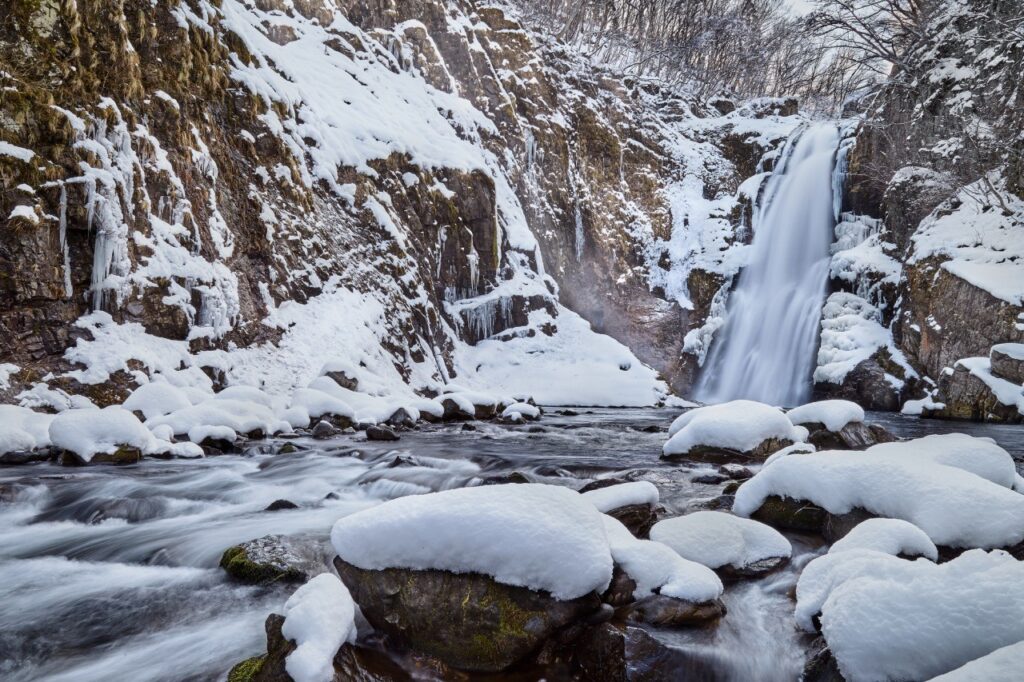
Start your trip by arriving at Sendai Airport. If you’re planning to explore more rural spots later, you can rent a car here. But if you’re sticking to city areas and places along the main train lines, public transport works great too – just hop on the Sendai Airport Access Line straight into Sendai Station (about 25 mins). It’s a smooth ride and drops you right in the heart of the city.
From around 10:00, spend the morning exploring central Sendai. Walk along Jozenji-dori Avenue, check out Zuihoden Mausoleum, or stop by Aoba Castle Site for a panoramic view and a bit of samurai history. You can easily get around by foot, subway, or city loop bus (Loople Sendai is super handy for tourists).
By midday, grab lunch at one of the many local restaurants serving gyūtan (grilled beef tongue), the city’s signature dish. It’s a must-try while you’re in town, and most places near Sendai Station or Ichibancho Shopping Arcade will have great sets with rice, soup, and pickles.
In the afternoon, around 14:00, head out to Akiu Onsen for a relaxing nature escape. If you’re driving, it’s about 30 minutes from the city. By bus, take the Sendai City Bus from Sendai Station to Akiu (about 50 minutes). Once there, unwind in a traditional onsen, visit Rairaikyo Gorge for a scenic walk, or stop by the Akiu Craft Park if you’re into local art and pottery. End your day with a peaceful evening in a ryokan (traditional inn) if you’re staying overnight.
Day 2
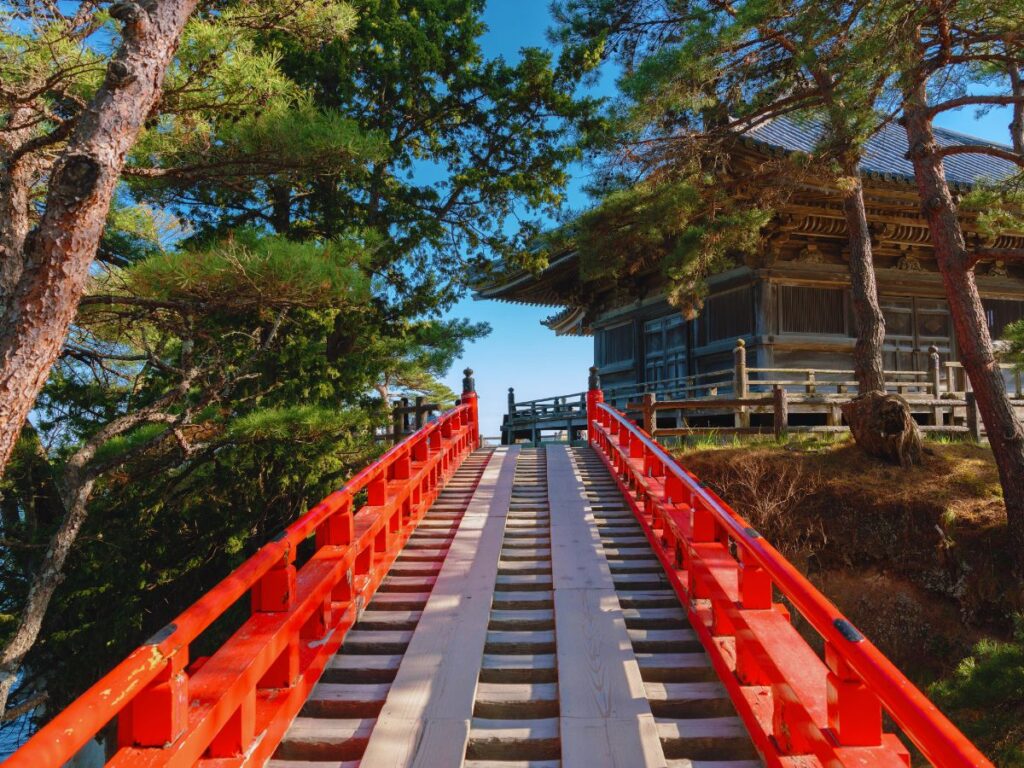
Start the day with a trip to Matsushima. From Sendai Station, it’s an easy 40-minute ride on the JR Senseki Line to Matsushima Kaigan Station. Trains run regularly and it’s a lovely ride along the coast. If you’re driving, it’s about 45 minutes depending on traffic.
From around 10:00, explore the area – take a bay cruise, visit Zuiganji Temple, walk along the Fukuura Island Bridge, or just enjoy the sea breeze from one of the viewpoints. Matsushima has a laid-back vibe and plenty of little shops and cafes along the waterfront, so take your time soaking it all in.
In the afternoon, make your way to Naruko Onsen for some deep relaxation. If you’re using public transport, head back to Sendai then take the JR Rikuu East Line to Naruko Onsen Station (takes about 2.5 hours in total).
By car, it’s around 1.5 to 2 hours from Matsushima. Once you arrive, enjoy the onsen town atmosphere – steaming hot spring streets, traditional inns, and scenic mountain views. Dip into one of the public baths or just chill at a foot spa, then end your day with a slow evening in the peaceful mountains.
Day 3
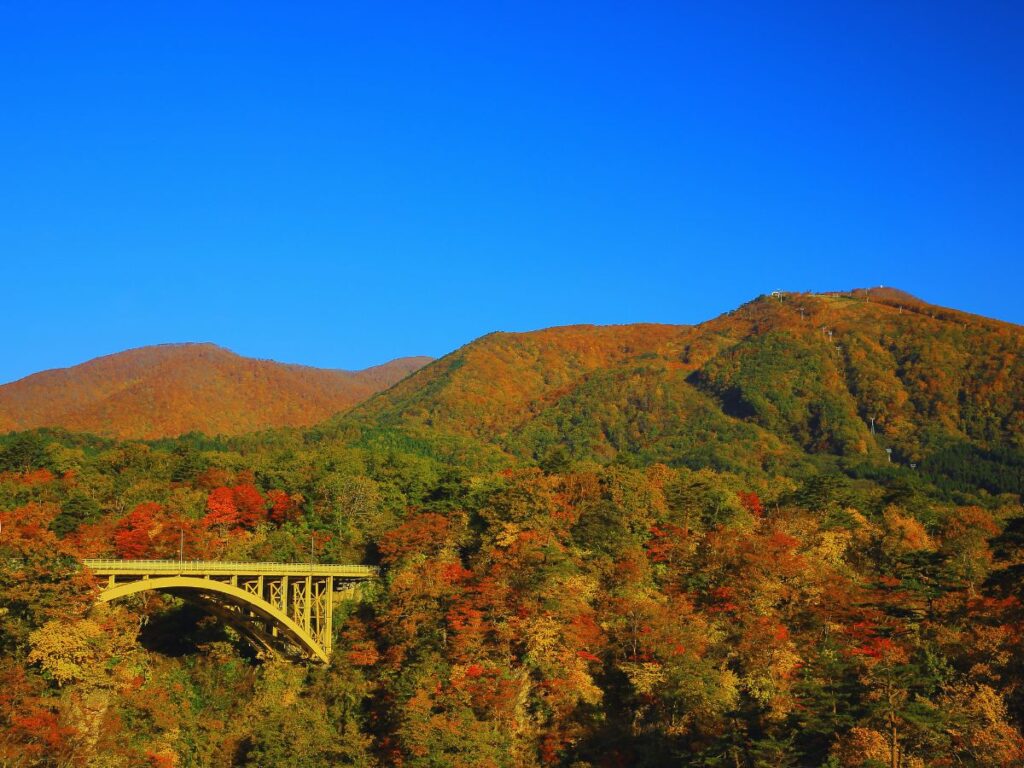
Kick off your final day with a choice of local activities around the Naruko area. If you’re up for nature, go for a walk on the Miyagi Olle “Osaki–Naruko Onsen Course”, a scenic trail that takes you through rural landscapes, forests, and peaceful onsen spots. It’s easy to reach on foot from Naruko Onsen town, and signage along the course makes it beginner-friendly.
If you’re more into history or engineering, head over to Naruko Dam for some sightseeing. The dam area also offers a visitor centre and panoramic views of the reservoir, especially pretty in autumn.
By early afternoon, start making your way back towards Sendai. If you’re driving, it takes about 90 minutes. By train, take the JR Rikuu East Line again, with a transfer at Furukawa onto the Tohoku Shinkansen, which gets you back to Sendai in around 90 minutes total. Once you’re back in the city, from around 15:00, enjoy a bit of shopping or chill before heading to the airport.
What Makes Miyagi Worth the Trip
![Where to go in spring in Japan Shiroishi River [Miyagi Prefecture]](https://flipjapanguide.com/wp-content/uploads/2022/02/Where-to-go-in-spring-in-Japan-Shiroishi-River-Miyagi-Prefecture-1024x576.jpg.webp)
Miyagi isn’t the flashiest place in Japan, but that’s part of its charm. It’s the kind of destination that quietly delivers — with beautiful coastlines, cosy hot spring towns, and food that’s properly satisfying.
There’s a nice balance here: culture without the crowds, nature without the hassle, and food that doesn’t try too hard but totally hits the spot. Everything feels easygoing, but still full of character.
If you’re looking for a trip that blends scenery, local flavour, and a slower pace, Miyagi’s a solid choice. No need to overthink it — just go and see where it takes you.

